In the world of sales, it’s common knowledge that it takes between 6-8 touches to convert sales qualified leads (SQLs) into customers.
Now, while that may be easy to execute with a handful of leads, what happens when you’re dealing with a database of tens or even hundreds of SQLs ready to be closed?
HubSpot sequences are up to the job.
HubSpot sequences enable you to automate personalized 1:1 emails to your prospects until they take action.
HubSpot Sequences is available to businesses using Sales Hub Starter .
What sequences do, in essence, is automate bottom of the funnel (BOFU) lead nurturing, without losing that personalized touch that’ll help keep your prospects engaged until they convert. But beyond that, how does HubSpot’s sequences fit into the bigger picture of your sales process?
Below are 4 ways you can simplify and optimize your sales process by employing sequences to personalize your 1:1 lead nurturing emails.
How to setup HubSpot Sequences. A step-by-step guide.

HubSpot Sequences vs. workflows. What’s the difference?
If you’re new to HubSpot, it’s easy to confuse sequences and workflows, as they can be both employed to achieve similar functions. Beyond that, there’s a world of difference between HubSpot sequences and workflows.
Workflows nurture leads into MQLs.
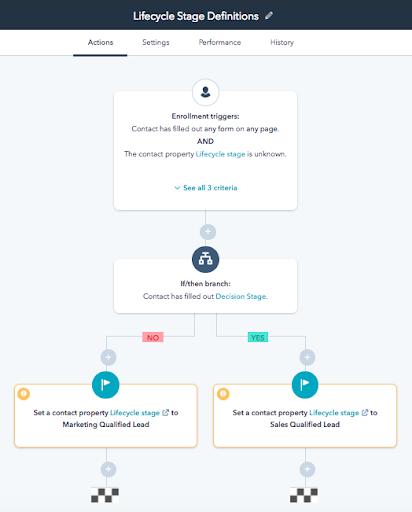
Workflows are primarily a marketing tool, designed for nurturing top of the funnel (TOFU) prospects into MQLs with relevant content offers before they can be passed along to sales to be closed.
Executing a well-designed workflow can move prospects from the awareness stage, positioning your business as the ideal solution provider with the knowledge and experience advantage over the competition.
Sequences take over from there.
HubSpot sequences, on the other hand, are designed for sales-ready leads. Sequences offer an avenue for sales personnel to pursue deals by engaging in highly personalized communications with bottom of the funnel (BOFU) leads, drawing on the info available on them within your CRM.
Sequences enroll contacts one at a time
A key factor that differentiates workflows from sequences is that while workflows are programmed to automatically enroll contacts that meet a set of predefined criteria, sequences are designed ideally for 1:1s and as a result, you’ll have to manually enroll contacts into sequences one at a time.
RELATED: Sequences vs. Workflows? Having a hard time choosing? Find out which your business needs here.
4 ways to simplify your sales process with HubSpot sequences.
1. Use unenrollment rules
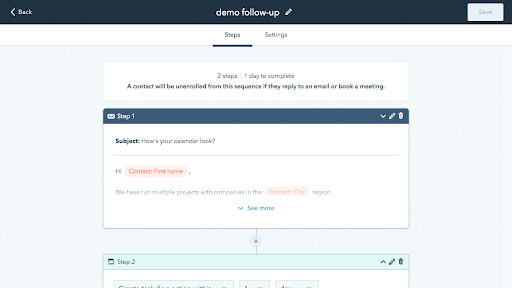
To get the most out of HubSpot’s sequences, ensure your sequences are programmed around the specific action you’re trying to get leads to take.
Sequences work based on conditional criteria that executes the steps until a predetermined action is carried out.
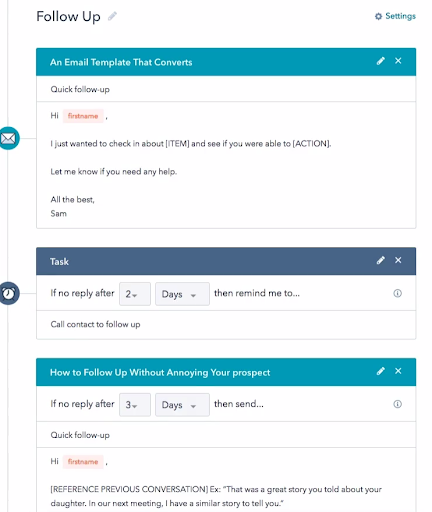
The trick is to ensure your sequence is stringed through with conditional rules specifying when to send the emails, and to stop when your prospect executes on a target action. It could be booking a discovery call with a rep, a demo, etc., conditional programming offers an excellent avenue to get a sequence executing until your prospect carries out an action that brings them further down your funnel and nearer a close.
2. Browse the sequence library
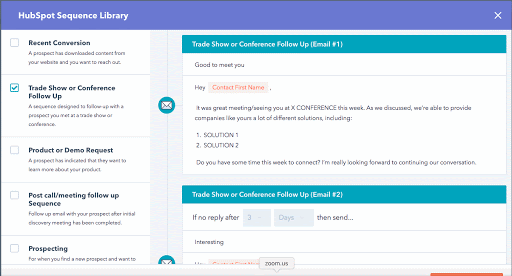
In case you’re new to HubSpot, getting started from scratch can be a bit challenging as you’ll have to create and customize email templates to suit your various personas, as well as edit the conditional rules for each sequence thread.
While you’re still building out your sequences, HubSpot’s sequence library offers ready-to-use sequences that can easily be tailored to suit your business needs so you can get started nurturing leads in less time.
3. Create personalized sequences that cater to specific personas
Understandably, a lot of your leads that have crossed the MQL threshold will fit into differing personas and as a result, trying to nurture them all with the same sequence may result in lower engagement and conversion rates for your business.
The trick here is to design sequences that are suited to each buyer persona and their buyer’s journey.
For example, take two contacts that have been passed on to sales. Contact A was recently acquired via a popup form on your blog, before being warmed up with several touches to qualify as an MQL. Contact B, on the other hand, is a current customer that’s aware of your business’s service offerings and has been passed on to sales to upsell.
While a basic informational sequence touching on your general service offerings might be great for getting Contact A to convert, Contact B might require more specialized follow ups that touch on their history with your service offerings, while highlighting the benefits of the solution you’re trying to upsell.
Carefully study your buyer personas and design sequences that suit each buyer’s journey so that at that critical nurturing stage, you can be sure you’re speaking directly to their needs.
4. Analyze your HubSpot Sequence performance.
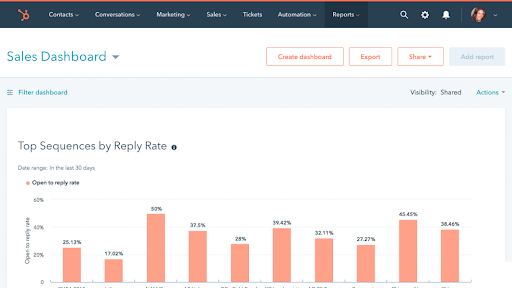
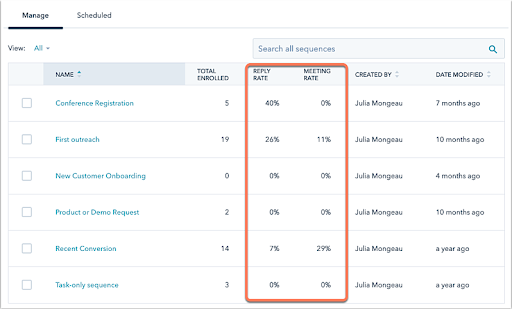
Once you’ve been using HubSpot’s sequence tool, you’ll find the sequence dashboard and summary tool an ideal companion that offers a 360° view of your sequence campaigns.
With stats ranging from open, to reply and meeting rates, the sequence dashboard helps you measure the individual efficiency of each of your sequences to know those working and those not working quite as well. That way, you can be better able to determine how to optimize them.
Additionally, this can also serve as a great avenue for split testing sequences so you can choose and share the best performers with your team.
Within the greater picture of your business’s inbound marketing and sales efforts, sequences play an indispensable role, in that they help cover up the last stretch of ground that determines if and how much of your MQLs are converted into sales. In that light, it’s only appropriate to say that your sales strategy ultimately depends on how well your sequences are designed and executed, since they indirectly determine a huge portion of your sales revenue.
That’s why you need to have a proactive outlook that will guarantee your sequences are being optimized nonstop to keep generating sales.
Struggling to get HubSpot’s sequences working for you? Find out how we can help!



